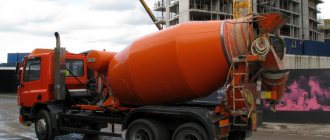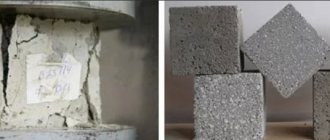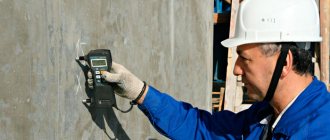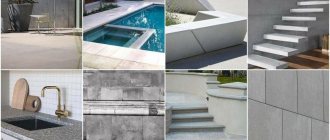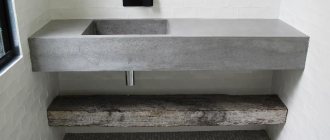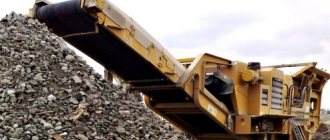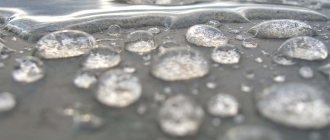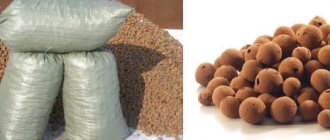perfume007 - 08/25/2019 Kirill Kupin lived in Kiev and worked in marketing for a confectionery company - until a friend from Russia suggested starting the production of concrete furniture. We started in 2020, and a year later we moved the business to Moscow. Today “Hardkey” brings in 1.1 million rubles per month.
An idea from America and a year of experiments.
One day, a friend Alexey Kolesnikov from Moscow came to visit Kirill. He said that during a trip to Los Angeles he saw an unusual hotel - all the furniture in it was made of concrete. Neither in Russia nor in Ukraine at that time did anyone do such things. Alexey was so inspired that he invited Kirill to produce the same furniture. In January 2020, friends set aside $30,000 (about 1,900,000 rubles) from their personal savings for a future project. Kirill contributed $5,000, Alexey contributed the rest. The Moscow comrade became a passive investor - Kirill was involved in launching the workshop in Kyiv himself. The shares were divided proportionally - 50 to 50. Kirill bought part of his share with the salary that they agreed upon at the beginning of the project. Kirill quit his job and rented a 49 m² premises in a residential area of Kyiv on the territory of a former car depot. The option cost 3,000 hryvnia per month (7,700 rubles). It was a small workshop without partitions. They invested 15,000 hryvnia (38,800 rubles) into the renovation - they insulated the room, installed light, repaired the roof, and installed shelving. At the time of the start, Kirill knew nothing about concrete. For example, that there are a large number of types of this material - each for its own purpose. The young man heard out of the corner of his ear that there is some kind of impregnation that is used to coat the product after grinding, some additives that increase strength... But Kirill did not have exact recipes, so he started looking for them on the Internet.
Concrete furniture is mass produced only in the USA - all content on this topic is in English. But the problem was not the language barrier: many types of raw materials and additives were simply not sold in Kyiv. Kirill decided to select ingredients based on what was available in Kyiv construction stores.
I started with the simplest thing: I bought a bag of cement and a bag of sand for 62 hryvnia (160 rubles). The molds were made from ordinary plastic flower pots. The first experiments were unsuccessful. For example, it was not possible to make products with thin walls: the concrete would crack when it dried, and with thick walls it would look unsightly.
When I tried to make countertops, I also ran into problems. For strength, Kirill added granite chips to the concrete. After pouring, it was necessary to clean the top layer on the ends of the table for beauty - the granite stuck out and spoiled the appearance of the product. He solved the problem by mastering shotcrete technology. With it, the first layer of concrete was applied under air pressure - exactly the same as when painting with a spray gun. And only then the solution with stone chips was poured.
The first experiments - molds for flowerpots were made from plastic flower pots.
I had to try a large number of recipes, starting with an ordinary construction screed - a mixture of sand, cement and water.
Usually this screed is used to level the floor. It could have been simpler - purchase a ready-made version from the USA. The basic version - an algorithm of actions and a recipe - cost $2,000 (about 130,000 rubles). The complete one, which included raw materials and some tools, cost $8,000 (521,000 rubles). But at that time it seemed to Kirill to be too expensive an investment. As a result, much more was spent on the experiments - about $25,000. True, it is possible that American manufacturers relied on raw materials that are not available either in Ukraine or in Russia. Then, when buying a ready-made option, the money would be wasted.
It turned out to be difficult to work alone, because concrete products weigh a lot. After four months of experimentation, Kirill realized that he needed an assistant. At first, the employee received 250 hryvnia per day (647 rubles). Then, instead of the daily payment, a monthly fixed payment appeared - 9,000 hryvnia (23,000 rubles).
Through experience we came up with our recipe - a solution of eight ingredients. In addition to cement, the composition contains plasticizers - special additives that increase plasticity so that the solution uniformly fills the entire form, and reduce the displacement of concrete. The latter is important because when the product dries, the water evaporates and pores form. Because of them, strength decreases.
In addition, reinforcing fiber is added to the solution. Essentially, this is reinforcement for a concrete product, which relieves some of the loads. In building slabs, for example, steel rods play the role of reinforcement, but they cannot be used for concrete furniture.
In addition to raw materials, I had to buy tools for processing concrete from construction stores: angle grinders, a grinder with water supply, and a vibratory grinder. And also abrasives and chemical compounds - to add to the solution and clean finished products. Over the course of the year, they spent another 220,000 rubles on them.
The main equipment in the workshop for the production of concrete products is a vibrating table. It is needed so that the concrete compacts during drying. When the product vibrates, air comes out of the pores, and the strength of the material increases.
It took a whole year to experiment and prepare the workshop for full-fledged operation. In January 2020, an understanding of the recipe and technology was formed. - by association with the famous Swedish furniture brand.
After the start, it became clear that several zones were needed for work - so that there was somewhere to pour concrete into molds, polish it and grind it. We had to separate the zones from each other with screens: according to the technology chosen by Kirill, the concrete is polished by pouring water, and splashes fly in all directions
The first pours in the Kiev workshop on a homemade vibrating table - this is what the lower part of the tabletop looks like 1.4 m by 0.9 m
First samples in Kiev, 2020 - 1,481,600 RUR
| Raw materials | 660 000 ₽ 660 000 ₽ |
| Equipment | 265 000 ₽ 265 000 ₽ |
| Chemistry | 220 000 ₽ 220 000 ₽ |
| Salaries | 171 600 ₽ 171 600 ₽ |
| Workshop rental and utilities | 132 000 ₽ 132 000 ₽ |
| Workshop renovation | 33 000 ₽ 33 000 |
First client
In mid-2020 - while Kirill was still experimenting with the recipe - Alexey found his first client in Moscow. One of the banks was opening a new office and wanted to completely decorate it in a “concrete” style. The bankers did not find a suitable workshop in Moscow and were ready to wait until Hardkey learned how to make acceptable products.
As soon as the experiments with concrete were over, Kirill gave Alexei Fr. The bank ordered four large composite concrete tabletops 1.2 by 0.6 meters: two consisted of eight sections, two of four. The bankers ordered the bases for the tables from outside. Each section cost the buyer 10,000 rubles. Hardkey's net profit amounted to 60,000 rubles.
Customers indicated the required dimensions. Kirill and his assistant cast the products in their Kiev workshop, processed them, applied a protective coating, and then transported the finished furniture to Moscow. The sale was registered in the name of an individual entrepreneur, which was owned by a friend of Alexey’s.
The bank liked the first pieces of furniture. For three months—until March 2020—Hardkey worked for its key and only buyer. The further we went, the more often we began to think about opening a similar workshop in Moscow.
Firstly, the sales market and the solvency of clients there are higher. Secondly, delivering products across borders, even for an existing customer, is too troublesome. Moreover, another major client appeared on the horizon. Alexey and his friends were building a coworking space of 1600 m². When they saw what Hardkey did for the bank, they also decided to decorate the entire interior in concrete. The order promised to be large.
It took a little less than an hour to pour one countertop weighing half a ton for a Moscow bank. There were 12 of them made in total.
Six days passed from the moment the formwork was assembled until the finished tabletop was delivered to the customer.
Launch of production in Moscow
First, Kirill came to the Russian capital for reconnaissance. On the spot, it turned out that several of Alexey’s friends were ready to invest in Hardkey. Four more partners joined the project and invested about 6,400,000 rubles in the business. Everyone received a share in the company, but at first the cooperation was not formalized and they worked on a trusting relationship. With that kind of money it was possible to launch serious production.
Before moving permanently, Kirill asked his new partners to help find premises for a workshop. The friends were far from production processes, so they primarily focused on transport accessibility and area - at least 200 m². One partner found a suitable workshop on the electrical territory. But when Kirill arrived at the place, it turned out that there was no running water or drains. This was critical: water was needed to create the concrete itself and its subsequent grinding, and drains were needed to wash tools from residual mortar after pouring the forms. On the other hand, the price was attractive - 80,000 per month.
There was a car wash ten meters from the workshop. Kirill agreed with its owner: for 7,000 rubles a month, he would give Hardkey unlimited water, and his employees would clean the equipment from concrete. With these services, the premises now cost 87,000 rubles, but the price was still satisfactory. For the same area, other tenants were asking 120,000-130,000.
Another production requirement was heating. In the cold, concrete hardens for a long time, and if the solution freezes before it has set, cracks will appear on the product. In the workshop that the partner found, there were no problems with heating.
The new workshop was built immediately with an eye toward expanding production. Kirill decided to make not only furniture from concrete, but also weld metal structures. So, if a client ordered a table, Hardkey could make not just one tabletop, but the entire product.
The entrepreneur rented an apartment not far from the workshop and began purchasing equipment. First of all, we purchased a professional vibrating table, tools and a compressor. A compressor is needed to do formwork - remove the formwork from the finished product under air pressure. To this were added two miter saws, welding equipment and a concrete mixer, scales, grinders and a vacuum cleaner. When the product is cleaned with a grinder with diamond discs, a lot of dust flies. If it is not collected immediately, then there will be a dust fog in the workshop. We welded the workbenches and work tables ourselves.
It took four months and 776,000 rubles to purchase and launch the new production.
| welding equipment | 200 000 ₽ 200 000 ₽ |
| Raw materials | 150 000 ₽ 150 000 ₽ |
| Repair | 150 000 ₽ 150 000 ₽ |
| Other tool | 110 000 ₽ 110 000 ₽ |
| Miter saws, 2 pcs. | 80 000 ₽ 80 000 ₽ |
| Vibrating table | 45 000 ₽ 45 000 ₽ |
| Compressor | 29 000 ₽ 29 000 ₽ |
| Concrete mixer | 12 500 ₽ 12 500 ₽ |
| Furniture | 0 ₽ 0 ₽ |
So Kirill tested different impregnations for concrete: the product was divided into sectors, a different composition was applied to each, and then they were signed and sprayed with water.
They checked which one absorbs water better. Employees
If in Kiev Kirill could cope with one assistant, then in Moscow he decided to hire two - to work with concrete and weld metal. Previous employee Nikolai also agreed to move to Moscow to launch a new workshop and set up production.
It turned out that workers in Moscow cost twice as much as in Kyiv. If in Ukraine a worker received 20,000 rubles a month, then in a new place they had to offer at least 40,000 rubles.
Kirill did not know the intricacies of local labor legislation and did not want to get involved with migrants so as not to violate anything. Therefore, I decided to hire only Russian citizens. Kirill himself works in Russia under a patent - it costs 5,000 rubles a month.
Working with concrete is hard physical work. Products need to be moved and loaded, and they weigh hundreds of kilograms. This requires young and resilient people. As a result, we managed to find two assistants on Avito.
In July 2020, Kirill and his workers began producing furniture for the Moscow coworking space Collider. It had to be fully equipped with concrete furniture - tables, cabinets, shelving, flowerpots and washbasins. The owners also wanted metal planters, metal structures for zoning the space, a kitchen area and concrete tiles for the walls.
We started with tables: the first bulk part of the order was 27 concrete tables of two types, for six and for four workplaces. The tabletops were not cast entirely, but in parts - 138 pieces had to be made.
First, the molds had to be created, then the solution had to be poured and the finished products processed. It turned out that three people were not enough for this. I had to look for employees again. Kirill offered to work with those with whom he collaborated back in Kyiv. They agreed to help and moved to Moscow for a while.
Kirill had to live in the same rented apartment with two employees from Ukraine in order to save money on rent. Everything would be fine, but Kirill had a wife and little daughter who periodically came to Moscow. It was difficult to live next to two strange men in the same apartment, but I had to endure it - all for the sake of the prosperity of the company.
Four months later, we managed to assemble a team of seven people who adopted the experience from the Kyiv guys and were already able to work autonomously.
Order for coworking space
After the tabletops, Kirill was asked to make a concrete reception desk for the Collider. It turned out that the length of the stand was five meters and the weight was three tons. It had to be poured right on the spot - it was impossible to remove such a huge and heavy product from the workshop. This was done in several stages, since the base must be strong to support the upper concrete elements. Noisy welding and installation work had to be done at night so as not to disturb employees from nearby offices.
Using the same scheme, another non-standard object was made in the coworking space - a 12-meter long bar counter.
Then Hardkey employees created an amphitheater in the coworking space - a stepped recreation area made of metal structures 6 meters high and 4 meters high. We also had to figure out how to do all this on the spot. The customer met halfway and agreed to the experiments. For such a loyal attitude towards contractors, Hardkey made discounts: for example, the reception cost the owners of the coworking space 350,000 rubles, although its real market price is half a million.
During this period, the coworking space was Hardkey’s only customer. The profit was 450-500 thousand rubles per month.
According to Kirill’s calculations, during the year of cooperation with Collider, Hardkey workers mixed 22 tons of concrete, processed and assembled metal structures from 13 kilometers of profile pipe. But most importantly, Hardkey has learned to make not only mass-produced things like tabletops or concrete flowerpots, but also large non-standard products.
Now the concrete interior of the coworking space acts as a showroom for Hardkey. Kirill brings potential clients here and shows them what the company can do.
The reception desk at the coworking space was flooded for 13 hours: it started at 11 am and ended at 1 am
Bar counter for coworking: length 12 meters, weight - 1.7 tons
Cladding tiles for coworking walls: each 1.2 × 0.8 m plate weighs 32 kg
New workshop and LLC
The workshop that housed the production in Moscow was one large hall without partitions. It was uncomfortable in such an open space. Kirill began looking for a new workshop - at least twice as large in area and with several rooms to separate welding and metal cutting from concrete production.
It turned out that right there, on the territory of the electrical plant, a workshop of 416 m² was rented out. For a long time they could not find a tenant for it and gradually reduced the price. A room twice as large would cost only one and a half times more - 123,000 rubles per month. There was also water supply and sewerage, which was so lacking in the old workshop.
At the new location it was even possible to set up a paint booth to paint and varnish concrete and metal structures. The first customers did not need to paint the products - they were simply coated with matte varnish. But new clients appeared, and the range expanded. 150,000 rubles were spent on repairs, and another 130,000 were spent on a fire alarm.
In January 2020, the entrepreneur and his partners formed an LLC to fix the partners' shares.
Promotion
In addition to word of mouth, another source of orders was Instagram, the promotion of which costs about 3,000 rubles per month. Back in Kyiv, Kirill opened a “Hardkeys” account to post photos of the work process and finished products. At first I did it myself, then my wife got involved - she was on maternity leave and herself offered to help.
Potential clients started writing in direct messages. Small products - bedside tables, urns and flowerpots - are made in Moscow. But large furniture like tables and bar counters made of concrete is difficult to find.
The thing is that, for example, a flowerpot measuring 15 × 15 cm is easy to make. Concrete dries, but due to the fact that the object is small, it does not deform, even if there are no special additives in the composition. When the product is large, the task becomes more complicated - when it dries, the concrete heats up and begins to tear it apart. To prevent this from happening, it is necessary to complicate the composition, add plasticizers and other substances. There are no recipes on the Internet, and it’s difficult to find one yourself—it took Kirill a whole year.
Some clients come through the Hardkeys account on Instagram, where the guys post photos of their work.
You can even make an organizer for pens out of concrete
Cost of products
Despite the fact that each customer comes with his own idea, over two years of work Hardkey has formed a list of serial products - countertops, bedside tables, flowerpots or washbasins. If for non-standard products the price has to be calculated individually each time, then with serial items it is easier. For example, a concrete pot - a cube with sides 40 centimeters - costs 15,000 rubles, with a cost of just over 5,000.
The price is formed based on the cost of the product and the price list of competitors. Hardkey is a newcomer to the market, so they try to make prices a little lower than others, working with both companies and private customers. The most popular among buyers are flowerpots and tables. The cheapest serial product is an organizer for stationery for 1,500 rubles. The most expensive is a 2.5-meter long washbasin for 70,000 rubles.
The most expensive things are not things made of concrete, but custom metal structures that Hardkey makes to order. For example, a metal mezzanine was welded for one client for 611,000 rubles. True, they buy mainly to order - serial products account for about a fifth of the total sales volume.
Such a concrete planter will cost the buyer 15,000 rubles
Bowl washbasin - 19,000 rubles
Results and plans
The company's current turnover is about 2,500,000 rubles per month. Net profit depends on the number of orders. On average, Hardkey makes 60-70 interior items of various sizes every month for a dozen customers and earns about a million from it.
The plans are to increase the number of clients. To do this, you need to hire managers and open a sales department. In parallel with this, Kirill is looking for interior designers who will sell interior items from Hardkey in their projects.
We recently launched our website, but it is still being finalized. There have been no sales through it yet.
Another big challenge is to start making smart furniture and embedding various devices into concrete. For example, wireless chargers for phones, chips - to turn on the lighting on a table from a mobile phone, to enable concrete to perform tasks using gadget signals. Now this is at the experimental stage, but the price list already includes bedside tables with built-in wireless chargers.
Another idea is to produce furniture from so-called warm concrete. Kirill himself has a large dining table on the veranda. If you drink tea on a winter morning, it’s not very comfortable to sit down to it - it’s cold. There is an idea to build heating elements into concrete. This way you can combine the harsh appearance of concrete and metal with home comfort.
One of the clients ordered such an office cabinet with wireless charging for phones
Profit for June 2020 - 1,100,000 RUR Operating expenses for June 2020 - 1,369,000 RUR
| Salary and taxes | 789 000 ₽ 789 000 ₽ |
| Raw materials and consumables | 400 000 ₽ 400 000 ₽ |
| Rent and utilities | 150 000 ₽ 150 000 ₽ |
| Fare | 30 000 ₽ 30 000 |
Source
How do you like this business? Write in the comments...
Sections for storing things of the most practical owners
Jeremy Kaplan is the designer who came up with another great and interesting version. There's space to put your stuff at the top, and there's space to stash a stack of magazines at the bottom. Chic and at the same time functional.
Varieties
Previously, only garden furniture was made from concrete. The street exterior was complemented by tables, benches, and benches made from these raw materials. But modern concrete furniture is not only garden benches; the range of products is represented by armchairs, chairs, tables - coffee tables, desks, dining tables, as well as cabinets and shelves. Kitchen countertops are often made from this raw material; they can be of any shape: triangular, oval, square, round. And for catering establishments, concrete bar counters are offered.
In addition to furniture, design elements made from concrete are actively used in modern interiors. These are not only sculptures, but also vases, columns, stands for magazines, candlesticks, stationery accessories, and fountains in gardens.
Also, this raw material, or rather slabs made from it, is used for cladding buildings. Such facades are a common occurrence in urban environments. They have many advantages: such panels are not afraid of frost or heat, are durable, and fireproof.
Today, concrete paths in private gardens and vegetable gardens are gaining popularity. Moreover, these can be either cast or tiled sidewalks. The latter can be made independently.
garden furniture
Armchair
Chair
Kitchen countertop
Dinner table
Bar counter
Vases
Magazine stand
Candlesticks
Placement nuances
Designers see no restrictions in the use of concrete furniture:
- A small coffee table on wheels can be placed in the living room. Here it is appropriate to use a concrete stand for a TV or an aquarium. The material is durable, like granite, and will easily withstand any load.
- A bedside table and nightstands will look natural in the bedroom.
- Bookshelves will find their place in an office or library.
- Outdoor tables and benches are actively used in the garden, open gazebo, and summer cottage.
- But concrete is most relevant in the kitchen. Work areas are completely made from it. They look especially good in combination with wooden facades. Designers increasingly began to offer concrete bar counters and dining tables - they look original and will serve for decades. Also, some convenient little thing would be appropriate here, for example, a stand for bowls for feeding pets.
Pros and cons of furniture made from chipboard, criteria for choosing quality material
Products made from these raw materials are also actively used in the bathroom. An interesting design move is a concrete bathtub. It can be of any shape: traditional oval, round, square. Concrete sinks, shelves, racks, cabinets, and countertops can also be used. The material is ideal for the bathroom: it is not afraid of moisture, does not rot, does not rust, and lasts a long time. Shells with a rough surface look interesting. You can combine them with shiny, glossy plumbing fixtures.
Designers recommend placing sinks on wooden countertops or cabinets.
As for the garden plot, any furniture made of concrete looks appropriate here. It looks especially good surrounded by greenery and flowers. To make the products look harmonious, you should combine them with wooden elements and textiles. For example, put several small pillows on the bench - they will add coziness.
Coffee table on wheels
Bedside table
Bookshelves
Outdoor table with benches
Work area in the kitchen
Bath
Sink
Tips for placing concrete furniture:
- Products should not be placed on flower beds or lawns. It is almost impossible to move them, and caring for the plants will be significantly more complicated.
- You should not place more than 3 concrete objects nearby. Such furniture is accent, designer, it adds color to the interior or exterior. But if you make the entire furnishings from concrete, all originality will be lost and you will end up with a cold, ill-conceived design.
- It is important to choose the right size of concrete furniture, based on the area of the garden plot or room.
- Concrete products are combined with eclectic, loft, and minimalist styles. Although some designers quite successfully place such models in classic interiors.
Characteristics of chipboard furniture, types of products, rules for their selection
Concrete furniture cannot do without accessories. The material itself is gray and cold. Bright colors are appropriate in the interior. You can put a soft fluffy rug under a concrete coffee table. Place flowers or candles on the tabletop. You can also use covers, pillows, blankets and other textiles.
It is highly undesirable to place products on flower beds or lawns, since caring for plants will be significantly more complicated
Concrete furniture is accent and adds color to any interior or exterior, so you shouldn’t make the entire furniture out of concrete
The size of the products depends on the area of the room or garden plot
Concrete interior items are combined with eclectic, loft, and minimalist styles
Desert that warms you up on cold days
There are manufacturers who have invested heavily in technology to come up with lightweight concrete for furniture. Such is the case with the LCDA team, which calls itself an innovative and creative creator company.
They boast that they were able to create such a base - “Béton Lège” or fans of concrete with various characteristics. And the most important quality of this achievement is a very interesting and modern look.
Tips for choosing
Don't be afraid to place furniture made of concrete in your garden or apartment. It looks beautiful, is practical and comfortable. Of course, before purchasing it is worth considering a number of nuances:
- Pay attention to the composition of the material, the presence of additives and plasticizers. All information about this must be contained in the product certificate. If a low-quality mixture was used, the furniture will quickly lose functionality.
- The surface of the product must be well sanded and treated with moisture-resistant compounds, then it will be durable and last a long time.
The design of concrete furniture offered by manufacturers today is extremely diverse. The material is plastic; products of various shapes and sizes are made from it. Most often it is combined with wooden elements, sometimes with metal, glass, and natural stone. The surface can be rough or decorated with patterns.
Concrete furniture is still unusual for a wide range of people, but designers are already using such products with might and main. They go perfectly with modern interiors, such as industrial, minimalism, loft, but are completely inappropriate for Provence or country.
Who said cement can't be gentle?
This beauty (natural colors) is not large in size - length 130, height 30, width 70 cm, weight 93 kg. But it’s not the numbers that make it such an interesting piece of furniture.
It is its simplicity and conciseness that delights others. This idea is suitable for both indoor and outdoor use, and you can decorate the table without an elegant floral design.

